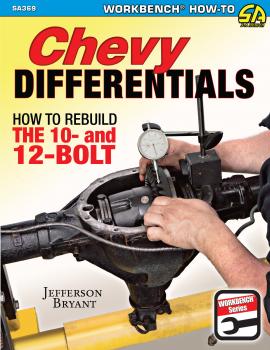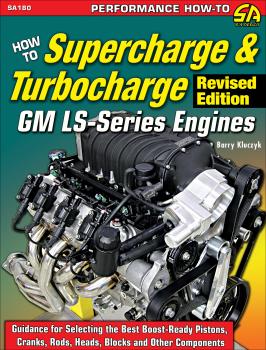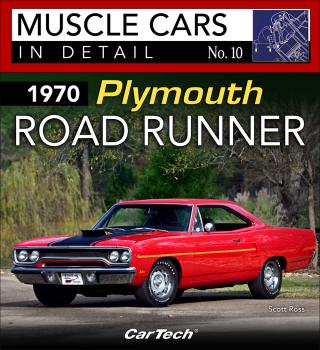Ingram
Все книги издательства IngramNew Hemi Engines 2003-Present
When Chrysler released the «new» third-generation Hemi engine in 2003, the automotive public placed high expectations on the Hemi’s triumphant return. The Hemi Gen III 5.7L, 6.1L, and 6.2L supercharged and 6.4L engines didn’t disappoint; they produced copious amounts of horsepower and torque while delivering exceptional durability. These powerful engines occupy the engine bays of new Challengers, Chargers, Magnums, 300C, Durangos, Jeep Grand Cherokees, and Ram trucks. Many of these engines have been used for high-performance service or logged hundreds of thousands of road miles, and as a result, many need to be rebuilt. <p>Long-time Mopar engineer, racing coordinator, and veteran author Larry Shepard delivers thorough instructions for each crucial step of the rebuilding process. Before commencing engine tear down, Shepard shows you how to perform compression and leak down testing to accurately assess the health of the engine. Disassembly and comprehensive inspection instructions are provided so you can determine and remedy any underlying problems. Expert insight allows you to select the ideal parts package for your rebuild, whether OEM replacement or compatible and complementary high-performance parts are selected. The most pertinent information for the latest machining practices is provided, so you can coordinate with the machine shop to return the block, head, intake, and other surfaces to like-new condition. Assembling the cylinder heads as well as accurately measuring, checking clearances, and test fitting parts is detailed, so you’re sure all components are within spec and ready for final assembly. Finally, comprehensive step-by-step instructions are provided for assembling all components into a completed engine. <p>The modern Hemi engine is lighter and stronger and offers far better drivability and performance than its predecessors. However, after hundreds of thousands of miles, extreme use, or high-performance applications, these rugged engines require a professional caliber rebuild. With this book, you can confidently complete your Hemi rebuild and get your car or truck back into action.
1001 NASCAR Facts
For nearly 70 years, NASCAR has been the premier sanctioning body for organized Stock Car Racing in the United States. During that time, the sport has grown from a Southern, regional series to a global brand with its races telecast in more than 100 countries around the world. Author John Close details the earliest races of the 20th Century that laid the groundwork for the formation of NASCAR through today's modern events at mega-race stadiums across the country. Presented in an easy-to-read decade-by-decade «Fact Format,» this books allows you to spend a couple of minutes or hours at a time learning about the Cars (and Trucks), Personalities, Tracks, and Milestones of NASCAR, America's most popular and attended form of motorsports. Close, a longtime NASCAR journalist, author, team member, and race-day Spotter, also includes dozens of rare and informative photos that take you from the famed «Beach Course» at Daytona to the high banks of today's NASCAR tracks. A must read for any NASCAR, Stock Car Racing, and American Motorsports fan, the book will provide hours of interesting entertainment as it uncovers rare information and statistical anomalies.
The Illustrated History of Triumph Sports and Racing Cars
The Triumph Motor Company is known around the world for its iconic sports cars. The hugely popular TR series, Spitfires, and GT-6s represent the quintessential British sports car; rugged good looks were combined with performance and economy at a price everyone could afford. These sports cars are always in demand and prized by British car collectors, racers, and open-air motoring enthusiasts. Triumph understood the connection between competition success and sales success and was able to parlay rally and road racing wins into the best-selling sports cars in the world, particularly in the United States during the 1950s and 1960s. The Works competition cars notched victories at Le Mans, Sebring, the Monte Carlo rally, and many others and inspired privateers to take their cars to the track. Every model came from a bloodline of racing.<p>In <i>The Illustrated History of Triumph Sports and Racing Cars</i>, Triumph historian G. William Krause reviews every model in the sports car lineup. He covers the history, design evolution, and performance specifications from the first sports cars in the 1930s through the final cars built in 1981. Throughout Triumph's history a number of pivotal moments could have significantly changed the company's fortunes. This book also looks at the «what if» cars that never made it into production, including photos. <p>Although they have not been built for more than three decades, their mark on sports car history is undeniable. Whether you're a fan of the spartan brutes of the 1950s or the refined comfort and performance of the last TRs, you will find the backstory of your favorites here.
Lost Muscle Cars
This book is a collection of stories written by enthusiasts about their quest to find these extremely rare and valuable muscle cars. Lost Muscle Cars includes 45 intriguing stories involving some of the most significant American iron ever created during the celebrated muscle car era.
GM Turbo 350 Transmissions
GM Turbo 350 Transmissions: How to Rebuild & Modify guides you through the complex rebuild procedure of GM’s popular rear-wheel-drive automatic transmission. This is the only book on this subject in full color.
Chevy Differentials
Millions of Chevrolet vehicles were built and sold in the 1960s and 1970s, and the great majority of those were rear-wheel-drive models with differentials known as 10-bolts or 12-bolts. In Chevy Differentials: How to Rebuild the 10- and 12-Bolt, author Jefferson Bryant walks you through the entire process of procuring, evaluating, and rebuilding the perfect differential for your GM application.
Holley Carburetors
Author Mike Mavrigian guides you through each important stage of the Holley carb rebuilding process, so you have the best operating carburetor for a particular engine and application. In addition, he explains carb identification as well as idle, mid-range and high-speed circuit operation, specialty tools, and available parts.
How to Supercharge & Turbocharge GM LS-Series Engines - Revised Edition
GM LS-series engines are some of the most powerful, versatile, and popular V-8 engines ever produced. They deliver exceptional torque and abundant horsepower, are in ample supply, and have a massive range of aftermarket parts available. Some of the LS engines produce about 1 horsepower per cubic inch in stock form–that's serious performance. One of the most common ways to produce even more horsepower is through forced air induction–supercharging or turbocharging. Right-sized superchargers and turbochargers and relatively easy tuning have grown to make supercharging or turbocharging an LS-powered vehicle a comparatively simple yet highly effective method of generating a dramatic increase in power. <p>In the <b>revised edition</b> of <i>How to Supercharge & Turbocharge GM LS-Series Engines</i>, supercharger and turbocharger design and operation are covered in detail, so the reader has a solid understanding of each system and can select the best system for his or her budget, engine, and application. The attributes of Roots-type and centrifugal-type superchargers as well as turbochargers are extensively discussed to establish a solid base of knowledge. Benefits and drawbacks of each system as well as the impact of systems on the vehicle are explained. Also covered in detail are the installation challenges, necessary tools, and the time required to do the job. Once the system has been installed, the book covers tuning, maintenance, and how to avoid detonation so the engine stays healthy. Cathedral, square, and D-shaped port design heads are explained in terms of performance, as well as strength and reliability of the rotating assembly, block, and other components. <p>Finally, Kluczyk explains how to adjust the electronic management system to accommodate a supercharger or turbocharger. <i>How to Supercharge and Turbocharge GM LS-Series Engines</i> is the only book on the market specifically dedicated to forced air induction for LS-series engines. It provides exceptional guidance on the wide range of systems and kits available for arguably the most popular modern V-8 on the market today.
1970 Plymouth Road Runner
By 1969, the muscle car war among Ford, General Motors, and Chrysler had reached a fevered pitch. Plymouth's Road Runner, Mopar's intermediate entry, was leading the charge. For 1970, the Road Runner had its strongest year yet as it housed the best street V-8s Chrysler had to offer.</p><p>Author Scott Ross retraces the history of the Road Runner and brings the 1970 model year into full focus. The stripped-down Road Runner exemplified the essence of a purpose-built muscle car: brute power and stunning acceleration. A new aggressive grille and Air Grabber hood provided an audacious yet tasteful performance statement. The back-to-basics 'Bird had a unique character with its iconic cartoon Road Runner graphics and beep-beep horn.</p><p>Underneath the skin, the Road Runner lived up to its persona. The 335-hp 383 was one of fastest 383s Chrysler built because it was fitted with the 440 camshaft, heads, and manifolds for even more performance. The 440 Six Pack car generated 390 hp and gained a reputation as a stout street performer. And at the top, the conservatively rated 425-hp 426 Hemi set the standard for performance.</p><p>The Road Runner was lighter than the Cuda and somewhat overbuilt as it was one of the toughest and most consistent muscle cars. To transfer all this power to the ground, the Road Runner was equipped with the A-833 4-speed or TorqueFlite 727 automatic. With a torsion-bar suspension and heavy-duty rear end, the Road Runner handled well. However, these are just a few of the highlights of this complete story.<p></p>Each volume in the In Detail Series provides an introduction and historical overview, an explanation of the design and concepts involved in creating the car, a look at marketing and promotion, an in-depth study of all hardware and available options, as well as an examination of where the car is on the market today. Also included are paint and option codes, VIN and build tag decoders, as well as production numbers.
Jeep Wrangler YJ 1987-1995
Jeepers rejoice! Bring new life to your classic Jeep YJ with this new guide to off-road performance. More than 685,000 YJs were built from 1986 to 1995. They featured heavier wider leaf springs, track bars, and sway bars for improved handling. A massive range of parts are offered for these vehicles, which include lift kits, wheels up to 37 inches, larger brake rotors, high-performance aluminum remote reservoir shocks, stronger driveshafts and U-joints, and Dana 60 conversions. In Jeep Wrangler YJ 1987-1995: Advance Performance Modifications , veteran author Don Alexander covers the 4.0 engine, transmissions (automatic and manual), transfer cases, axles, differentials, and driveshafts, steering boxes, brake upgrades, shocks, springs and lift kits, chassis strengthening, and interior upgrades. Whether you want to do some simple upgrades, such as a lift and tire combination, or want to go all out with a rock crawler-style suspension and an engine swap, this book will guide you through the process.









